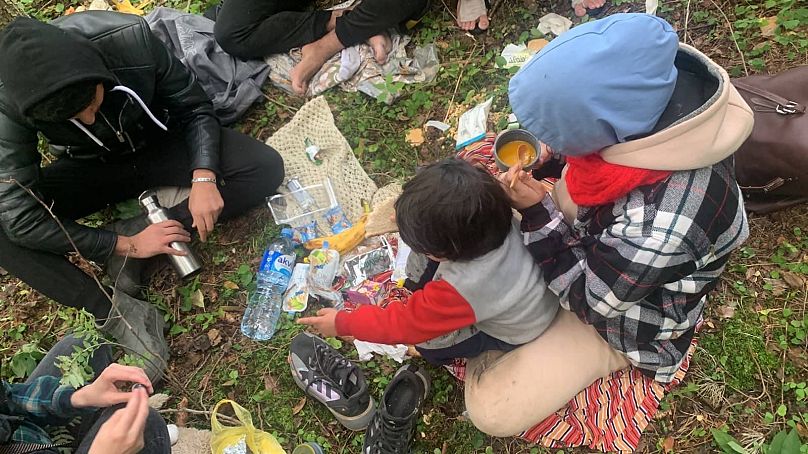Lithuania’s government recently approved controversial legislation to formalise pushbacks as an official policy at the Belarus border.
The Lithuanian-Belarussian border is littered with the bodies of migrants, who have died trying to enter the EU, human rights groups have alleged.
Sienos Grupe, a Lithuanian humanitarian organisation, has collected a list of around 30 people, whose families lost contact with them on Europe’s eastern frontier.
The group is working hard to help loved ones find their missing relatives, piecing together information and grimly scouring refugee camps, hospitals and morgues.
Much of what is happening slips under the radar, they say, as migrants and their families are often too scared to come forward, fearing a run-in with the law -- and the transience of people on the move makes it doubly difficult for them to seek help.
'No entry zone'
Complicating their effort is the complete blackout by Lithuanian authorities in the border zone, which prevents humanitarian groups and journalists from monitoring the area.
“The problem is we simply don't know”, Vakarė, a volunteer at Sienos Grupe who asked that we not use their full name, told Euronews. “There’s this entire darkened invisible line that you’re not supposed to go past”.
“No-one knows what's happening inside”.
People crossing the border have also accused Polish border forces of dragging dead bodies to the Belarussian side, who simply bury the remains -- a claim strongly refuted by Poland.
“Migrants are meaningless, faceless people to most, they’re not even [considered as] human,” said Vakarė.
“Nobody’s very passionate about making sure their bodies aren't left to rot in the forest”.
Known as Europe’s forgotten migration crisis, Lithuania, Poland and Belarus have pushed migrants back and forth across each other’s frontiers since 2020, in a situation likened to ping-pong.
Vilnius and Brussels accuse Minsk of weaponising migration -– inundating the EU’s border with migrants as a form of hybrid warfare – while Lithuanian border guards have been repeatedly accused of violently pushing migrants back into Belarus.
In the meantime, people suffer.
The border area is a dank, dark forest, filled with swamps, that is regularly buffeted by tough weather conditions, and subzero temperatures in winter.
Meanwhile, migrants -- mostly coming from the Middle East, Africa or Asia -- often don't know how brutal winter conditions can be in the region, arriving without proper clothing or supplies.
Belarus has even been accused of pushing some migrants across the Lithuania border barefoot.
"They don't understand what harsh winters we have here," explained Vakarė.
"Everything is cold, slippery and dangerous. If you get injured, even if it's just a small one, it can mean you are completely unable to cope”.
"People can get in trouble very fast."
At least three migrants have lost their legs to frostbite in recent months, with many more suffering debilitating injuries to their hands and feet that will be with them forever.
In January, Sienos Groupe identified the body of one migrant, who was found dead in a river by a nature watcher in August, after receiving desperate messages from his wife in Sri Lanka.
It was what the NGO said they “feared would come true”: the first confirmed case of a migrant dying in Lithuanian territory.
In a statement, a spokesperson for Lithuania's Interior Ministry told Euronews authorities have "no data regarding dead migrants" at the border with Belarus.
They said the body found in the Neris river was of a Sri Lankan national, but did not confirm whether they were an "irregular migrant".
An investigation is ongoing.
'Agonising'
For those who have lost loved ones, the uncertainty is agonising.
“As a family, my brother's disappearance has left us feeling destroyed, and completely shattered,” said one relative of a missing person, who wished to stay anonymous for privacy reasons. “We do not know what to do to find him”.
“His wife and two little children in Syria are desperate for some news about him.”
Another woman was called from her husband's phone by the Lithuanian Border Guard in June, who ominously said they'd found his suitcase and valuables strewn in the forest.
During the border crossing, the man reportedly told his companions to leave him behind and that he wanted to call the border guards, as a pain in his foot made walking unbearable.
His whereabouts remain unknown.
“Every single day I get a message about a new missing person,” said Vakarė. “We don't have answers for these people. We don't have bodies. We don't have their stories.”
In January, Lithuania’s government approved controversial legislation to formalise pushbacks as an official policy.
It claims the exceptional situation on the border with Belarus justifies the law, though critics have pointed out it violates international law by denying people the right to asylum.
“Every single death is a fault of their policy,” Vakarė said. “The state pretends the bodies aren't there, that they are humane and doing everything they can, but it's still a spot of dirt on their reputation”.
“The bodies are very, very visible proof of the failure of the entire strategy.”












